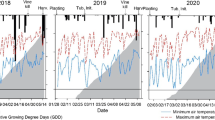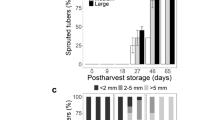Abstract
The growth and yield of plants from different-sized seed tubers derived from true potato seed were evaluated on a per stem, per plant, and per unit area basis using either single or multiple-sprout tubers. In single-sprout tubers, haulm dry weight per stem 47 days after planting was greater in the 40–60 g tubers when compared with that in the 5–10 g or the 10–20 g tubers. This resulted in greater tuber weight per stem in the 40–60 g tubers throughout the growing season. The number of tubers per stem was not affected by seed tuber size.
In multiple-sprout seed tubers of increasing size, total tuber number and total tuber weight, as well as weight of those tubers larger than 45 mm, increased on a per plant basis but decreased on a per stem basis. At different rates of planting, 1–5 g seed tubers produced smaller tubers than 5–10 g or 10–20 g seed tubers. Increased rate of planting resulted in non-significant yield increases per unit area in plots planted with 1–5 g seed tubers. The yield increases were significant when 5–10 g and 10–20 g seed tubers were planted at higher rates. The number of main stems per unit of seed tuber weight was five times greater in 1–5 g tubers compared with that in 40–60 g tubers. This resulted in low seed weights per hectare when small tubers were planted and in a high ratio of harvested to planted tuber weight.
Resumen
Se evaluó el crecimiento y rendimiento de las plantas provenientes de tubérculos-semillas de diferentes tamaños obtenidos de semilla botánica, en base a los resultados obtenidos por tallo, por planta y por unidad de superficie, utilizando tubérculos con un solo brote o con múltiples brotes. En los tubérculos con un solo brote, el peso seco del follaje por tallo a los 47 días después de la siembra fue mayor para los tubérculos de 40–60 g en comparación con el obtenido de los tubérculos de 5–10 g ó de los de 10–20 g. Esto dio por resultado un peso mayor de tubérculos por tallo para los tubérculos de 40–60 g, a través de toda la estación de cultivo. El número de tubérculos por tallo no fue afectado por el tamaño de los tubérculos-semillas.
En tubérculos-semillas con múltiples brotes y de tamaños de menor a mayor, el número total de tubérculos y el peso total de los mismos, al igual que el peso de los tubérculos mayores de 45 mm, se incrementó por planta, pero disminuyó por tallo. A diferentes densidades de siembra, los tubérculossemillas de 1–5 g produjeron tubérculos más pequeños que los producidos por tubérculos-semillas de 5–10 g ó de 10–20 g. La mayor densidad de siembra dio por resultado incrementos no-significativos de rendimiento por unidad de superificie en parcelas sembradas con tubérculos-semillas de 1–5 g. Los incrementos en el rendimiento fueron significativos cuando se sembraron tubérculos-semillas de 5–10 gy de 10–20 g, a mayores densidades. El número de tallos principales, por unidad de peso de tubérculos-semillas, fue cinco veces mayor en tubérculos de 1–5 g en comparación con el observado para tubérculos de 40–60 g. Esto dio lugar a bajos pesos de semilla por hectárea cuando se sembraron tubérculos pequenos y a una relación alta entre el peso de tubérculos cosechados y el de tubérculos sembrados.
Similar content being viewed by others
Literature Cited
Allen, E.J. 1978. Plant density.In: P.M. Harris (ed.) The potato crop. The Scientific Basis for Improvement. p. 279–326. Chapman and Hall, London.
Bremner, P.M. and A.K. El Saeed. 1963. The significance of seed size and spacing.In: J.D. Ivins and F.L. Milthorpe (ed.) The Growth of the Potato. Butterworths, London.
Davies, H.V. 1984. Mother tuber reserves as factors limiting potato sprout growth. Potato Res 27:209–218.
Devasabai, K. 1982. TPS research in Sri Lanka. True Potato Seed Letter 3(2). International Potato Center, Lima.
Devaux, A. 1984. True potato seed development. Circular, International Potato Center 12(3):6–7.
Gray, D. 1972. Spacing and harvest date experiments with Maris Peer potatoes. J Agric Sci Camb 79:281–290.
Headford, D.W.R. 1962. Sprout development and subsequent plant growth. Eur Potato J 5:14–22.
Iritani, W.M., R. Thornton, L. Weiler and G. O’Leary. 1972. Relationship of seed size, spacing, stem numbers to yield of Russet Burbank potatoes. Am Potato J 47:463–469.
Jarvis, R.H. 1977. An assessment of the value of different sizes of seed potatoes of main crop varieties. Exp Husb 32:102–114.
Moorby, J. 1967. Inter-stem and inter-tuber competition in potatoes. Eur Potato J 10:189–205.
Morris, D.A. 1966. Intersprout competition in the potato. I. Effect of tuber size, sprout number and temperature on sprout growth during storage. Eur Potato J 9:69–85.
Morris, D.A. 1967. Intersprout competition in the potato. 2. Competition for nutrients during pre-emergence growth after planting. Eur. Potato J 10:296–311.
Poats, S.V. 1983. Beyond the farmer: Potato consumption in the tropics:In: W.J. Hooker (ed.) “Research for the potato in the year 2000” p. 10–17. International Potato Center, Lima, Peru.
Rozier-Vinot, C. 1971. Certain aspects of the influence of the seed tuber and number of stems on the growth of the potato plant. Potato Res 14:219–231.
Song. B.F. 1984. Use of True Potato Seed in China. Circular, International Potato Center 12(2):6–7.
Wang, P. and C. Hu. 1982. In vitro mass tuberization and virus-free seed potato produc tion in Taiwan. Am Potato J 59:33–37.
Wattimena, G., B. McCown and G. Weis. 1983. Comparative field performance of potatoes from microculture. Am Potato J 60:27–33.
Wiersema, S.G. 1984. The production and utilization of seed tubers derived from True Potato Seed. Ph.D. Thesis, University of Reading, England. 229 pp.
Wiersema, S.G. 1985. Production and utilization of seed tubers derived from true potato seed.In: Report of the Planning Conference on Innovative Methods for Propa gating Potatoes, held December 1984. pp. 95–116. International Potato Center, Lima, Peru.
Wiersema, S.G. 1985. Production of seed potatoes derived from true seed. CIP Circular, International Potato Center 13(1):1–4.
Wiersema, S.G. A method to produce seed tubers derived from true potato seed. Potato Res (In press).
Author information
Authors and Affiliations
Rights and permissions
About this article
Cite this article
Wiersema, S.G., Cabello, R. Comparative performance of different-sized seed tubers derived from true potato seed. American Potato Journal 63, 241–249 (1986). https://doi.org/10.1007/BF02852936
Accepted:
Issue Date:
DOI: https://doi.org/10.1007/BF02852936




